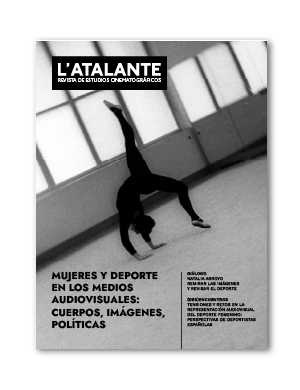22.01.2024
Avisos
Número actualNúmero 37
Publicado 1 enero 2024
Descripción de la publicación
Cuaderno
Mujeres y deporte en los medios audiovisuales:
cuerpos, imágenes, políticas
Diálogo
Natalia Arroyo. Remirar las imágenes y revisar el deporte
(Des)encuentros
Tensiones y retos en la representación audiovisual del deporte femenino:
perspectivas de deportistas españolas
Coordinado por: Manuel Garin, María Aparisi Galán
##issue.tableOfContents##
Tabla de contenidos
Mancheta del número
Presentación
Cuaderno
Diálogo
(Des)encuentros
Puntos de Fuga
Número completo
Sobre la revista
L’Atalante. Revista de estudios cinematográficos es una publicación semestral sin ánimo de lucro fundada en 2003, editada en Valencia (España) por El camarote de Père Jules y la Associació Cinefòrum L’Atalante.
L’Atalante está indexada en distintos catálogos, directorios, sumarios y bases de datos de revistas de investigación y divulgación científica. A nivel internacional, figura en Arts and Humanities Citation Index® y en Current Arts and Humanities® de Clarivate (EEUU); en Latindex (Sistema Regional de Información en Línea para Revistas Científicas de América Latina, el Caribe, España y Portugal); en SCOPUS de Elsevier (Países Bajos); en Library of Congress (EEUU); en DOAJ (Directory of Open Access Journals, Lund University); y en ERIH PLUS (European Referee Index for the Humanities and Social Sciences, Noruega). En España consta en la base de datos del CSIC de Revistas de Ciencias Sociales y Humanas ISOC; en el portal bibliográfico de literatura científica hispana DIALNET; en REBIUN (Red de Bibliotecas Universitarias); y cuenta con el sello de calidad de la FECYT (Fundación Española para la Ciencia y la Tecnología).
Dispone de más información en la pestaña Acerca del proyecto.

